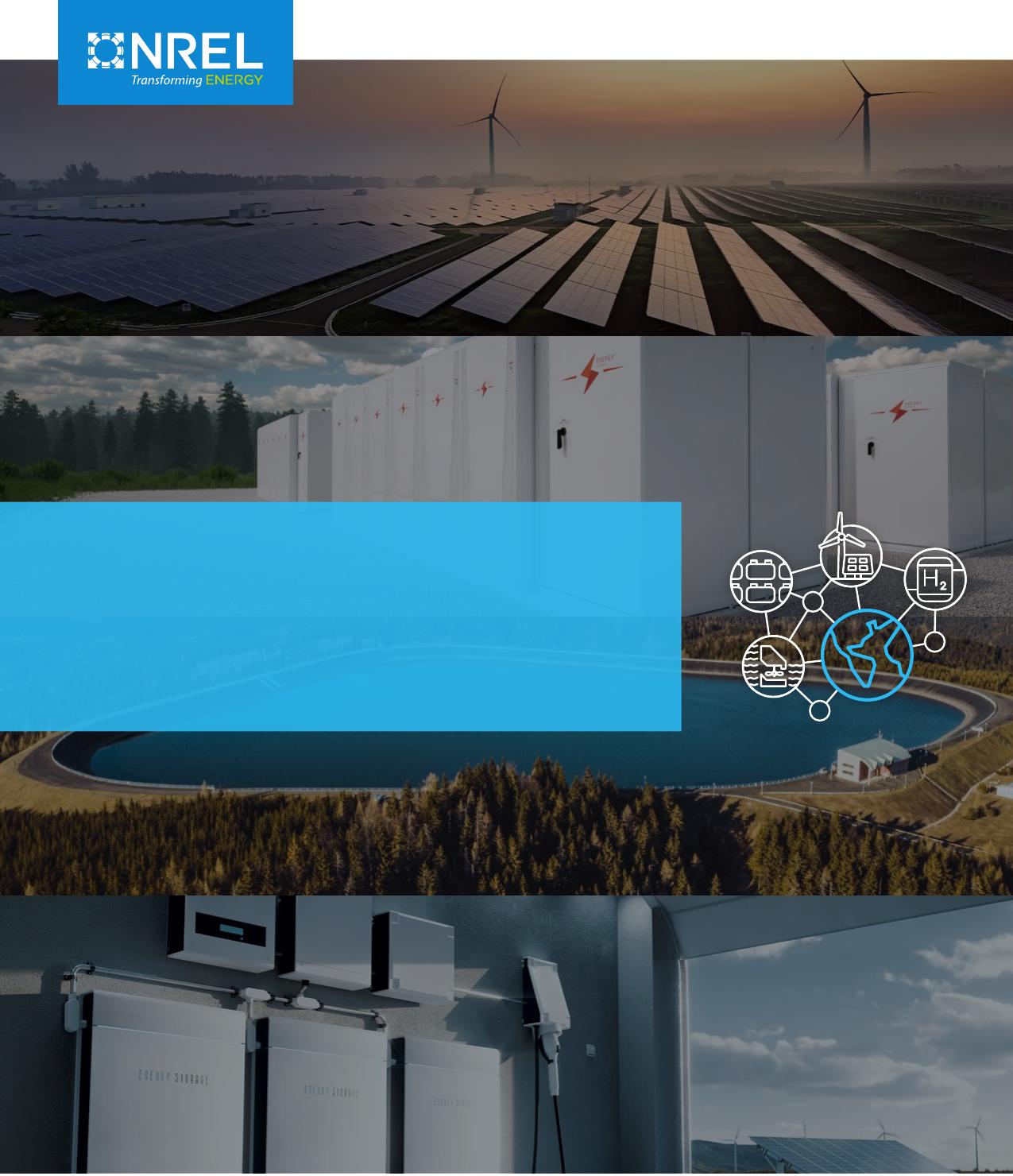A.WillFrazier,WesleyCole,PaulDenholm,ScottMachen,NathanielGates,andNateBlairStorageFuturesStudyEconomicPotentialofDiurnalStorageintheU.S.PowerSectorSuggestedCitation:Frazier,A.Will,WesleyCole,PaulDenholm,ScottMachen,NathanielGates,andNateBlair.2021.StorageFuturesStudy:EconomicPotentialofDiurnalStorageintheU.S.PowerSector.Golden,CO:NationalRenewableEnergyLaboratory.NREL/TP-6A20-77449.https://www.nrel.gov/docs/fy21osti/77449.pdf.StorageFuturesStudyEconomicPotentialofDiurnalStorageintheU.S.PowerSectorA.WillFrazier,WesleyCole,PaulDenholm,ScottMachen,NathanielGates,andNateBlairNOTICEThisworkwasauthoredbytheNationalRenewableEnergyLaboratory,operatedbyAllianceforSustainableEnergy,LLC,fortheU.S.DepartmentofEnergy(DOE)underContractNo.DE-AC36-08GO28308.FundingprovidedbyU.S.DepartmentofEnergyOfficeofEnergyEfficiencyandRenewableEnergySolarEnergyTechnologiesOffice,U.S.DepartmentofEnergyOfficeofEnergyEfficiencyandRenewableEnergyWindEnergyTechnologiesOffice,U.S.DepartmentofEnergyOfficeofEnergyEfficiencyandRenewableEnergyWaterPowerTechnologiesOfficeandU.S.DepartmentofEnergyOfficeofEnergyEfficiencyandRenewableEnergyOfficeofStrategicAnalysis.TheviewsexpressedhereindonotnecessarilyrepresenttheviewsoftheDOEortheU.S.Government.ThisreportisavailableatnocostfromtheNationalRenewableEnergyLaboratory(NREL)atwww.nrel.gov/publications.U.S.DepartmentofEnergy(DOE)reportsproducedafter1991andagrowingnumberofpre-1991documentsareavailablefreeviawww.OSTI.gov.CoverPhotosbyDennisSchroeder:(clockwise,lefttoright)NREL51934,NREL45897,NREL42160,NREL45891,NREL48097,NREL46526.NRELprintsonpaperthatcontainsrecycledcontent.iiiThisreportisavailableatnocostfromtheNationalRenewableEnergyLaboratoryatwww.nrel.gov/publications.PrefaceThisreportisoneinaseriesoftheNationalRenewableEnergyLaboratory’sStorageFuturesStudy(SFS)publications.TheSFSisamultiyearresearchprojectthatexplorestheroleandimpactofenergystorageintheevolutionandoperationoftheU.S.powersector.TheSFSisdesignedtoexaminethepotentialimpactofenergystoragetechnologyadvancementonthedeploymentofutility-scalestorageandtheadoptionofdistributedstorage,andtheimplicationsforfuturepowersysteminfrastructureinvestmentandoperations.Theresearchfindingsandsupportingdatawillbepublishedasaseriesofpublications.ThetableonthenextpageliststheplannedpublicationsandspecificresearchtopicstheywillexamineundertheSFS.Thisreport,thethirdintheSFSseries,performsasetofcost-drivenscenariosusingtheReEDSmodeltoexaminebothgrid-scalestoragedeploymentaswellasrelationshipsbetweenthisdeploymentandvariablerenewableenergy(VRE)penetration.Thisreportassessestheeconomicpotentialforutility-scalediurnalstorageandtheeffectsthatstoragecapacityadditionscouldhaveonpowersystemevolutionandoperationsTheSFSseriesprovidesdataandanalysisinsupportoftheU.S.DepartmentofEnergy’sEnergyStorageGrandChallenge,acomprehensiveprogramtoacceleratethedevelopment,commercialization,andutilizationofnext-generationenergystoragetechnologiesandsustainAmericangloballeadershipinenergystorage.TheEnergyStorageGrandChallengeemploysausecaseframeworktoensurestoragetechnologiescancost-effectivelymeetspecificneeds,anditincorporatesabroadrangeoftechnologiesinseveralcategories:electrochemical,electromechanical,thermal,flexiblegeneration,flexiblebuildings,andpowerelectronics.Moreinformation,anysupportingdataassociatedwiththisreport,linkstootherreportsintheseries,andotherinformationaboutthebroaderstudyareavailableathttps://www.nrel.gov/analysis/storage-futures.html.ivThisreportisavailableatnocostfromtheNationalRenewableEnergyLaboratoryatwww.nrel.gov/publications.TitleDescriptionRelationtothisReportTheFourPhasesofStorageDeployment:AFrameworkfortheExpandingRoleofStorageintheU.S.PowerSystemExplorestherolesandopportunitiesfornew,cost-competitivestationaryenergystoragewithaconceptualframeworkbasedonfourphasesofcurrentandpotentialfuturestoragedeployment,andpresentsavaluepropositionforenergystoragethatcouldresultincost-effectivedeploymentsreachinghundredsofgigawatts(GW)ofinstalledcapacityProvidesbroadercontextontheimplicationsofthecostandperformancecharacteristicsdiscussedinthisreport,includingthespecificgridservicestheymayenableinvariousphasesofstoragedeployment.Thisframeworkissupportedbytheresultsofscenariosinthisreport.EnergyStorageTechnologyModelingInputDataReportReviewsthecurrentcharacteristicsofabroadrangeofmechanical,thermal,andelectrochemicalstoragetechnologieswithapplicationtothepowersector.Providescurrentandfutureprojectionsofcost,performancecharacteristics,andlocationalavailabilityofspecificcommercialtechnologiesalreadydeployed,includinglithium-ionbatterysystemsandpumpedstoragehydropower.ProvidesdetailedbackgroundaroundthebatteryandPSHcostandperformancevaluesusedasinputstothemodelingperformedinthisreport.EconomicPotentialofDiurnalStorageintheU.S.PowerSectorAssessestheeconomicpotentialforutility-scalediurnalstorageandtheeffectsthatstoragecapacityadditionscouldhaveonpowersystemevolutionandoperationsThisreport.DistributedStorageCustomerAdoptionScenariosAssessesthecustomeradoptionofdistributeddiurnalstorageforseveralfuturescenariosandtheimplicationsforthedeploymentofdistributedgenerationandpowersystemevolutionAnalyzesdistributedstorageadoptionscenariostotestthevariouscosttrajectoriesandassumptionsinparalleltothegridstoragedeploymentsmodeledinthisreport.GridOperationalImplicationsofWidespreadStorageDeploymentAssessestheoperationandassociatedvaluestreamsofenergystorageforseveralpowersystemevolutionscenariosandexplorestheimplicationsofseasonalstorageongridoperationsConsiderstheoperationalimplicationsofstoragedeploymentandgridevolutionscenariostoexamineandexpandonthegrid-scalescenarioresultsfoundwithReEDSinthisreportStorageFuturesStudy:ExecutiveSummaryandSynthesisofFindingsSynthesizesandsummarizesfindingsfromtheentireseriesandrelatedanalysesandreports,andidentifiestopicsforfurtherresearchIncludesadiscussionofallotheraspectsofthestudyandprovidescontextfortheresultsofthisreportvThisreportisavailableatnocostfromtheNationalRenewableEnergyLaboratoryatwww.nrel.gov/publications.AcknowledgmentsWewouldliketoacknowledgethecontributionsoftheentireStorageFuturesStudyteamaswellasourU.S.DepartmentofEnergy(DOE)OfficeofStrategicAnalysiscolleaguesascorecontributorstothisdocument.ThosecontributorsincludeChadAugustine,BenSigrin,KevinMcCabe,andAshreetaPrasannafromtheNationalRenewableEnergyLaboratory(NREL)andKaraPodkaminerfromDOE.WewouldalsoacknowledgethefeedbackandcontributionsofotherNRELstaff,includingChadHunter,EvanReznicek,MichaelPenev,GregStark,VigneshRamasamy,DavidFeldman,andTrieuMai,Wealsowouldliketothankthetechnicalreviewcommitteeforinput,includingDougArent(NREL/Chair),PaulAlbertus,InesAzevedo,RyanWiser,SusanBabinec,AaronBloom,ChrisNamovicz,ArvindJaggi,KeithParks,KiranKumaraswamy,GrangerMorgan,CaraMarcy,VincentSprenkle,OliverSchmidt,DavidRosner,JohnGavan,andHowardGruenspecht.Finally,additionalthoughtsandsuggestionscamefromvarioustechnicalexpertsatDOE,includingPaulSpitsen,KathrynJackson,NehaRustagi,MarcMelaina,AndrewDawson,AdriaBrooks,SamBaldwin,SarahGarman.ThisworkwasauthoredbytheNationalRenewableEnergyLaboratory,operatedbyAllianceforSustainableEnergy,LLC,fortheU.S.DepartmentofEnergy(DOE)underContractNo.DE-AC36-08GO28308.FundingprovidedbyU.S.DepartmentofEnergyOfficeofEnergyEfficiencyandRenewableEnergySolarEnergyTechnologiesOffice,U.S.DepartmentofEnergyOfficeofEnergyEfficiencyandRenewableEnergyWindEnergyTechnologiesOffice,U.S.DepartmentofEnergyOfficeofEnergyEfficiencyandRenewableEnergyWaterPowerTechnologiesOfficeandU.S.DepartmentofEnergyOfficeofEnergyEfficiencyandRenewableEnergyOfficeofStrategicAnalysis.TheviewsexpressedinthearticledonotnecessarilyrepresenttheviewsoftheDOEortheU.S.Government.TheU.S.Governmentretainsandthepublisher,byacceptingthearticleforpublication,acknowledgesthattheU.S.Governmentretainsanonexclusive,paid-up,irrevocable,worldwidelicensetopublishorreproducethepublishedformofthiswork,orallowotherstodoso,forU.S.Governmentpurposes.viThisreportisavailableatnocostfromtheNationalRenewableEnergyLaboratoryatwww.nrel.gov/publications.ExecutiveSummaryTheStorageFuturesStudy(SFS)isamultiyearresearchprojecttoexploretheroleandimpactofenergystorageintheevolvingelectricitysectoroftheUnitedStates.TheSFSisdesignedtoexaminethepotentialimpactofenergystoragetechnologyadvancementonthedeploymentofutility-scalestorageandtheadoptionofdistributedstorage,andtheimplicationsforfuturepowersysteminfrastructureinvestmentandoperations.Thisreportmodelstheevolutionofdiurnalstorage(<12hours)withintheU.S.electricitysectorfrom2020through2050usingaleast-costoptimizationframeworkacrossmultiplecostscenariosbaseduponexistingpolicies.InthisfirstcomprehensivenationalU.S.analysisevaluatingdiurnalstorageagainstotherresources,wefindthatdiurnalstorageisextremelycompetitiveonaneconomicbasis.Wefindsignificantmarketpotentialfordiurnalenergystorageacrossavarietyofscenariosusingdifferentcostandperformanceassumptionsforstorage,wind,solarphotovoltaics(PV),andnaturalgas.Acrossallscenariosmodelleddeploymentforenergystorageexceeds125GWby2050,morethanafive-foldincreasefromthecurrentinstalledstoragecapacityof23GWin2020(themajorityofwhichispumped-hydro).Forbatterystorage,thereisatleast3,000timesmorebatterycapacityin2050thanexiststoday(FigureES-1).Dependingoncosttrajectoriesandothervariables2050storagedeploymentrangesfrom130to680GW,indicatingarapidlyexpandingopportunityfordiurnalstorageinthepowersector.Theseresults,basedupontechnologycostreductionsconsistentwiththe2020NRELStandardScenariospairedwithupdatedbatterycostprojections(AugustineandBlair,2021),highlightthefundamentaldriversofdiurnalstoragedeploymentandtheincreasingcompetitivenessofstorageresources.Acrossthesecost-drivenscenarios,variablerenewableenergy(VRE)reachespenetrationsof43-81%,butdoesnotachievethedeploymentneededtomeetdeepdecarbonizationgoals.Futureworkwillconsiderscenarioswithanacceleratedtransitiontoacleanenergygridby2035andtheresultingimpactonstoragedeployment.Weuseexpandedmodellingcapabilitiesthatallowustodifferentiatestorageresourcesbyduration.Inmostscenarios,themajorityofthisstorageinvestmentshave4-6hoursofduration,butthisdistributionvarieswithassumptionsforfuturenaturalgaspricesandrenewableenergycostadvancement.Withinthiseconomicdeploymentframework,theseresultsindicatethatdiurnalstoragecanlikelybesufficienttomeettheintegrationneedsofhighrenewableenergypenetrationsuptoatleast80%.viiThisreportisavailableatnocostfromtheNationalRenewableEnergyLaboratoryatwww.nrel.gov/publications.FigureES-1.Nationalstoragecapacityinthereferencecaseseparatedbystorageduration(left)andacrossallscenarios(right)SeeTable1(Methods:ScenariosandModelInputssection)forafulllistofresourcescenariosincludedhere.SeeFigureA-1intheappendixforadditionaldetailsongenerationandcapacitybytechnologyineachscenario.Whilestoragecanprovidemanyservicestothegrid,wefindthateconomicstoragedeploymentisdrivenprimarilybythecombinationofcapacityvalueandenergyarbitrage(ortime-shifting)value,andthatthecombinationofthesevaluestreamsisneededforoptimalstoragedeploymenttoberealized.WealsofindastrongcorrelationbetweenPVpenetrationandstoragemarketpotential.MoregenerationfromPVleadstonarrownet-loadpeaksintheeveningswhichincreasesthemarketpotentialofstoragecapacityvalue.MoregenerationfromPValsocreatesmorevolatileenergypriceprofileswhichincreasesthemarketpotentialofstorageenergytime-shiftingvalue.Collectively,theseresultsdemonstratethephaseddeploymentpathwayslaidoutinthefirstStorageFuturesStudyreport:TheFourPhasesofStorageDeployment:AFrameworkfortheExpandingRoleofStorageintheU.S.PowerSystem(Denholmetal.,2021).Shorterdurationstorageisdeployedinitiallyandovertimelongerdurationofstorageassetsdeployonacost-effectivebasis.Thisanalysisalsohighlightshowfarcost-effectivediurnalstoragealonecanmovethepowersectortowardscost-optimaldeployment.Buildinguponthisanalysisofeconomicdeploymentofdiurnalstoragefutureworkshouldexaminetherelationshipbetweendiurnalstorageandlonger-durationstorageresources,especiallyunderhighlydecarbonizedgridconditionsoutsidethescopeofthiswork,suchasthoseapproaching100%cleanenergy.Inaddition,moreworkisneededtounderstandtherelationshipbetweenstorageanddemand-sideflexibilityatanational-scale.Finally,whilethefocusofthisworkisonLi-ionbatteriesbecausethetechnologyhasgreatermarketmaturitythanotheremergingtechnologies,theresultsfromthisstudycanbegeneralizedtootherstoragetechnologiesthatcanmeetthesecostandperformanceprojections.Collectively,theseresultsspeaktothegrowingopportunityfordiurnalstoragetoprovideleast-costsolutionsinthepowersystem.viiiThisreportisavailableatnocostfromtheNationalRenewableEnergyLaboratoryatwww.nrel.gov/publications.TableofContents1Introduction...........................................................................................................................................12Methods:ModelImprovements...........................................................................................................33Methods:ScenariosandModelInputs...............................................................................................54Results:NationalDeployment.............................................................................................................85Results:DriversofDeployment..........................................................................................................96Results:OtherInteractionsandImpactofStorage........................................................................157DiscussionandFutureWork.............................................................................................................178References..........................................................................................................................................18Appendix....................................................................................................................................................21A.1ScenarioResults............................................................................................................................21A.2OperatingReserves........................................................................................................................26A.3StorageCostInputs........................................................................................................................26A.4ReEDSModelCaveatandLimitations.........................................................................................34A.5RelationshipwithWindPenetration..............................................................................................35A.6RegionalResults............................................................................................................................36ixThisreportisavailableatnocostfromtheNationalRenewableEnergyLaboratoryatwww.nrel.gov/publications.ListofFiguresFigureES-1.Nationalstoragecapacityinthereferencecaseseparatedbystorageduration(left)andacrossallscenarios(right)......................................................................................................viiFigure1.Nationalstoragecapacityinthereferencecaseseparatedbystorageduration(left)andacrossallscenarios(right)........................................................................................................................8Figure2.Loadandnetloadin2050inCaliforniafortheLowPVCostandLowWindCostCases(top);nationalpeakingcapacitypotentialfordiurnalstorage(upto12hours)asafunctionofPVpenetration(bottomleft)andnationaldiurnalenergytime-shiftingpotentialasafunctionofPVpenetration(bottomright)................................................................................................10Figure3.Cumulativebatterystoragedeploymentinscenarioswithgridservicesrestrictedforstorage,asindicatedbyscenarionames,withlowbatterycost(left),referencebatterycost(middle)andhighbatterycost(right)..........................................................................................................11Figure4.2050simulatedpeakingcapacitypotentialforstorageasafunctionofstoragepenetrationandduration(hatchedbars),comparedtothesimulatedeconomiccumulativestoragecapacityin2050ineachcase(solidbars)................................................................................................13Figure5.Cumulativecapacityinasubsetofscenariosofbatterystorage(topleft),transmission(topright),PV(bottomleft),andwind(bottomright)..................................................................15Figure6.Theamountofgenerationthatgoesthroughstoragein2050acrossallscenariosatthenationalandregionallevelsplottedagainstPVpenetration(left)andwindpenetration(right).........16FigureA-1.Capacitybytechnologyandyearinallresourcesensitivityscenarios....................................22FigureA-2.Generationbytechnologyandyearinallresourcesensitivityscenarios................................23FigureA-3.Capacitybytechnologyandyearinallstoragegridservicesensitivityscenarios..................24FigureA-4.Generationbytechnologyandyearinallstoragegridservicesensitivityscenarios..............25FigureA-5.Pumped-hydrocapitalcosts.....................................................................................................33FigureA-6.Loadandnetloadin2050inCaliforniafortheLowPVCostandLowWindCostCases(top);nationalpeakingcapacitypotentialfordiurnalstorage(upto12hours)asafunctionofwindpenetration(bottomleft)andnationaldiurnalenergytime-shiftingpotentialasafunctionofwindpenetration(bottomright)...........................................................................35FigureA-7.MapofReEDSreliabilityassessmentzones...........................................................................36FigureA-8.CumulativestoragecapacitybydurationandyearineachReliabilityAssessmentZone(showninFigureA-7)inthereferencecase..........................................................................37FigureA-9.Economicstoragedeploymentandpeakingcapacitypotentialofstoragein2050inallresourcesensitivityscenariosinERCOT(FigureA-7).........................................................38FigureA-10.Economicstoragedeploymentandpeakingcapacitypotentialofstoragein2050inallresourcesensitivityscenariosintheGreatLakeszone(FigureA-7).....................................39FigureA-11.Economicstoragedeploymentandpeakingcapacitypotentialofstoragein2050inallresourcesensitivityscenariosintheMISOEastzone(FigureA-7)......................................40FigureA-12.Economicstoragedeploymentandpeakingcapacitypotentialofstoragein2050inallresourcesensitivityscenariosintheMISOSouthzone(FigureA-7)....................................41FigureA-13.Economicstoragedeploymentandpeakingcapacitypotentialofstoragein2050inallresourcesensitivityscenariosintheMISOWestzone(FigureA-7).....................................42FigureA-14.Economicstoragedeploymentandpeakingcapacitypotentialofstoragein2050inallresourcesensitivityscenariosintheNPCCNewEnglandzone(FigureA-7).......................43FigureA-15.Economicstoragedeploymentandpeakingcapacitypotentialofstoragein2050inallresourcesensitivityscenariosintheNPCCNewYorkzone(FigureA-7)............................44FigureA-16.Economicstoragedeploymentandpeakingcapacitypotentialofstoragein2050inallresourcesensitivityscenariosinthePJMEastzone(FigureA-7).........................................45FigureA-17.Economicstoragedeploymentandpeakingcapacitypotentialofstoragein2050inallresourcesensitivityscenariosintheSERCEastzone(FigureA-7)......................................46xThisreportisavailableatnocostfromtheNationalRenewableEnergyLaboratoryatwww.nrel.gov/publications.FigureA-18.Economicstoragedeploymentandpeakingcapacitypotentialofstoragein2050inallresourcesensitivityscenariosintheSERCFloridaPeninsulazone(FigureA-7).................47FigureA-19.Economicstoragedeploymentandpeakingcapacitypotentialofstoragein2050inallresourcesensitivityscenariosintheSERCNorthzone(FigureA-7)....................................48FigureA-20.Economicstoragedeploymentandpeakingcapacitypotentialofstoragein2050inallresourcesensitivityscenariosintheSERCSoutheastzone(FigureA-7)..............................49FigureA-21.Economicstoragedeploymentandpeakingcapacitypotentialofstoragein2050inallresourcesensitivityscenariosintheSPPzone(FigureA-7).................................................50FigureA-22.Economicstoragedeploymentandpeakingcapacitypotentialofstoragein2050inallresourcesensitivityscenariosintheWECCCaliforniazone(FigureA-7)...........................51FigureA-23.Economicstoragedeploymentandpeakingcapacitypotentialofstoragein2050inallresourcesensitivityscenariosintheWECCMountainWestzone(FigureA-7)...................52FigureA-24.Economicstoragedeploymentandpeakingcapacitypotentialofstoragein2050inallresourcesensitivityscenariosintheWECCPacificNorthwestzone(FigureA-7)...............53FigureA-25.Economicstoragedeploymentandpeakingcapacitypotentialofstoragein2050inallresourcesensitivityscenariosintheWECCRockyMountainzone(FigureA-7).................54FigureA-26.Economicstoragedeploymentandpeakingcapacitypotentialofstoragein2050inallresourcesensitivityscenariosintheWECCSouthwestzone(FigureA-7)...........................55ListofTablesTable1.ResourceSensitivityScenariosIncludedintheStudy....................................................................5Table2.StorageServiceRestrictionScenariosUsedintheStudy,EachPerformedwithHigh,Reference,andLowBatteryCapitalCostProjections...............................................................................6TableA-1.ResultsforWind,PV,andTotalRenewableEnergyPenetrationin2050AcrossallResourceSensitivityScenarios..............................................................................................................21TableA-2.ReserveRequirementsinReEDS.............................................................................................26TableA-3.ReferenceBatteryCapitalCosts...............................................................................................27TableA-4.LowBatteryCapitalCosts........................................................................................................29TableA-5.HighBatteryCapitalCosts.......................................................................................................311ThisreportisavailableatnocostfromtheNationalRenewableEnergyLaboratoryatwww.nrel.gov/publications.1IntroductionRecentcostdeclinesformanyenergystoragetechnologies,notablylithium-ionbatteries,andincreasingdeploymentofvariablerenewableenergy(VRE)technologies(predominantlywindandPV)haveheightenedinterestinstorageasagridresource(BrownandSappington,2020;DenholmandMargolis,2016;Duanetal.,2020;Jorgensonetal.,2018).However,thetotalmarketpotentialforstorageandtheeffectsthatstoragecapacitycouldhaveonpowersectorevolutionandoperationsremainunclear.Estimatingthemarketpotentialforstorageiscomplex(Beuseetal.,2020;Daviesetal.,2019).Manygridservicesthatstorageprovides,includingpeakshaving,energytime-shifting,andoperatingreserveprovisions,havedecliningvaluewithstoragepenetration(Brijsetal.,2019;Denholmetal.,2020).Furthermore,thesevaluesarehighlydependentonthegridsystemconditionsandcanchangeovertimedependingontheoverallevolutionofload,loadflexibility,andthemixofgenerationtechnologiesinthepowersector(HartnerandPermoser,2018;Mallapragadaetal.,2020).Storagedevicesalsohaveanadditionalsystemdesignconsiderationthattraditionalgeneratorsdonothave,namelytheselectionofthedurationofstorageinvestments.Wedefinedurationastheusableenergycapacity(inunitsofwatt-hours,Wh)—afteraccountingforlossesandmaximum/minimumstate-of-charge—dividedbythepowercapacity(watts,W).Durationisthusmeasuredinhours.A100MWsystemwitha4-hourdurationwouldbecapableofstoringupto400MWhofusableenergy.Durationinfluencesthecostofastoragedevice.A6-hour100-MWstoragedevicewillcostmorethana4-hour100MWstoragedevicebecauseoftheadditionalenergycapacityneededinthe6-hourdevice(ColeandFrazier,2020).Thevalueofgridservicesprovidedbystoragealsogrowswithduration,butthecostofthisadditionalenergycapacitymustbecomparedtothisadditionalvalueandassessedonafullsystemlife-cyclebasistodeterminetheoptimaldurationofastorageinvestment.Furthermore,storageismoresensitivetochronologythantraditionalgeneratorsbecauseofthisfiniteduration(PinedaandMorales,2018).Thestate-of-chargeofastoragedeviceischronologicallylinked,andthisimpactshowitcanbeusedatanygiventime.Andunliketraditionalgenerators,storagedoesnotactuallygenerateelectricity,soitsoperationisentirelydependentonthedispatchofallothergridresources.Properlycapturingthesechronologicalconsiderationsinlarge-scalemodelsthatcanprojectmarketpotentialisachallenge(Bistlineetal.,2020).Theabilityofstoragetoprovidepeakingcapacityisafunctionofbothstoragedurationandnetloadshape(Royetal.,2020),wherenetloadisdefinedasloadminusVREgeneration.Initiallyrelativelyshortdurationsofstoragecanreliablyservedemandduringthehighestpeaks,butasstoragepenetrationgrowsthewidthofthenetloadpeakswiden.Holdingstoragedurationconstant,thisleadstoadecliningcapacitycreditforstoragewithincreasingpenetration.However,thisdeclineincapacitycreditcanbeoffsetbyinstallingstoragedeviceswithlongerdurationsbutathighercost.TheshapeofthenetloadprofilealsochangeswithinvestmentsinVRE,andthischangesthetechno-economicpotentialofprovidingpeakingcapacityfromdifferentdurationsofstorage(Frazieretal.,2020).2ThisreportisavailableatnocostfromtheNationalRenewableEnergyLaboratoryatwww.nrel.gov/publications.Energytime-shiftingvaluecomesfromstoragechargingwhenpricesarelowanddischargingwhenpricesarehigh,sothedurationofstorageandshapeoftheenergypriceprofiledeterminethepossiblevalueofthisservice.Priceprofilescanvarywidelyacrossspatialregionsandchangewithinvestmentsinnewgeneration,transmission,andstorageresources.Low-costgenerationfromPVandwinddrivepricesdownduringperiodsofhighgeneration.Transmissioninvestmentscanreducecongestion,whichcanreducethefrequencyandmagnitudeofpricespikes(Wangetal.,2017).Energytime-shiftingfromstoragecanraiseoff-peakpricesandlowerpeakprices,andthisleadstodecliningenergytime-shiftingvaluewithincreasedstoragepenetrationandaneventualtechno-economiclimitwherethevolatilityofpriceprofilesisnotlargeenoughtoovercomelossesfromstorage(Brijsetal.,2019).Forthiswork,weaddnewcapabilitiestotheRegionalEnergyDeploymentSystem(ReEDS)capacityexpansionmodeltoincludedetailedrepresentationofthegridservicesprovidedbydiurnalstorage.Explicitlyconsideredwithinthemodelingframeworkaretherelationshipbetweentheseservicesandstorageduration,thedecliningvalueoftheseserviceswithstoragepenetration,andtheevolvingtechno-economicimplicationsofthechanginggridinfrastructure.Theimpactsofchronologicaloperationonallthesefactorsarealsoconsideredatanhourlytemporalresolution.Seethemethodssectionformoredetailsofthesemodelingimprovements.Tolimitscope,storagewithdurationsshorterthan2andlongerthan12hoursarenotconsideredinthiswork.Inaddition,costandperformanceinputsresultedinscenarioswithupto80%nation-widerenewableenergypenetrationandadditionaldriverstoreachhigherpenetrationsofrenewableenergyarenotconsidered.Theobjectiveofthisstudyistoprovideaframeworkforunderstandinghowdiurnalstoragedeploymentisinfluencedbytheevolutionofthepowergridandhowdiurnalstoragedeploymentinfluencestheoperationandinvestmentsofotherresources.ThoughourstoragecostprojectionsarebasedonLi-iontechnologies,theresultsofthisworkareapplicabletoanytechnologythatcanachievethecostandperformancevaluesusedasmodelinputs.3ThisreportisavailableatnocostfromtheNationalRenewableEnergyLaboratoryatwww.nrel.gov/publications.2Methods:ModelImprovementsWeusetheReEDScapacityexpansionmodel,whichrepresentstheU.S.powersystemin134regionsconnectedbyaggregatedtransmissioncorridors,toperformleast-costsystemwideoptimizationofpowersystemretirementsandinvestmentsingeneration,transmission,andstoragecapacitythrough2050(Brownetal.,2020).Weoptimizeinvestmentsinthepowersysteminsequentialtwo-yeartimesteps;powersystemoperationisoptimizedineachbiennialtime-stepwithlimitedtemporalresolution.Becausestorageoperationdependsgreatlyonchronology(Yousifetal.,2019),weaddtoReEDSamoduleoutsidetheoptimizationthatsimulatessystemoperationatanhourlychronologicalresolution.Parametersrelatedtostorage—suchascurtailment,storagedispatch,capacitycreditofVREandstorage,energytime-shiftingvalue,andtherelationshipbetweenstorage,transmission,andcurtailment—aredeterminedfromtheresultsofthishourlydispatchandusedtoinformtheinvestmentoptimizationsinthenextsolveyear.Hourlygeneration,storagedispatch,transmission,andenergypriceprofilesareobtainedbyperformingasimpleleast-costproductiondispatchusingthesimulatedgenerationcapacityandtransmissionnetworkfromReEDS.Thisdispatchisperformedin24-hourblocksforeachcalendardayandresultsarestitchedtogethersuchtheinter-daydecisionsarenotconsidered.Weusehourlynetloadprofilesfrom2012loaddataandtime-synchronouswindandPVprofilesobtainedbymultiplyingmodeledwindandPVcapacitybyhourlycapacityfactorprofilesfrom2012weatherdata(Draxletal.,2015;Senguptaetal.,2018).Start-upcostsandminimumgenerationconstraintsarenotenforcedtokeeptheproblemtenable,buttheresultingprofilesareadjustedlatertoaccountforthesefactors.Curtailmentisdeterminedbycomparingthetime-seriesprofilesofgeneration,transmission,andnetload.GenerationprofilesareadjustedbasedonminimumgenerationlevelsobtainedfromtheTransmissionExpansionPlanningandPolicyCommittee(TEPCC)database(Frewetal.,2019).Generatorsthatareonbutgeneratingbelowthislevelarebroughtuptotheirminimumgenerationlevel.Generatorsthatareonandabovetheirminimumgenerationlevelaredeemedtohave“headroom”andcouldrampdowntoavoidcurtailingwindandPVgeneration.Adjustedgenerationandnettransmissionprofilesaresubtractedfromregionalnetloadprofilesandanynegativevaluesareinterpretedascurtailment.ThesechronologicalcurtailmentprofilesareaggregatedtothecoarsetemporalresolutionusedintheReEDSoptimizationandenforcedthere.MarginalcurtailmentratesaredeterminedbysimulatingadditionalVREgenerationwhileconsideringthetime-seriesprofilesofnetloadandremainingtransmissioncapacity.Thechronologicalcurtailment,transmission,andnetloadprofileshaveadditionalutilityinthecalculationoftheinteractionsbetweencurtailment,transmission,andstorage;bycomparingtheseprofilestogether,wedeterminetheabilityoftransmissioninvestmentsbetweenadjacentregionstoreducecurtailmentbyreducingcongestionduringhourswhenthereiscurtailment.Wealsoperformasimplechronologicaldispatchofvariousdurationsofstoragetodeterminetheeffectsofstorageoncurtailment.Thesehourlychronologicalcalculationsincreasetheabilityofthemodeltocharacterizethevalueofsystemflexibilityintheformofstorageortransmission.4ThisreportisavailableatnocostfromtheNationalRenewableEnergyLaboratoryatwww.nrel.gov/publications.Theregionalhourlypriceprofilesareadjustedforstart-upcostsbeforestoragetime-shiftingvalueiscalculated.Start-upcostsalsocomefromtheTEPCCdatabase(Frewetal.,2019).Withineachcalendarday,ifageneratorwasoffatanypointthenitsstart-upcostisspreadoutacrosseachhourweightedbygeneration.Fractionalstart-upcostsareused,basedonthemaximumoutputofthatgeneratorforthatday.Ineachhour,thesumofthestart-upcostplusthevariableoperatingcostiscomparedtotheenergypriceinthatregionforthathour.Ifthereisageneratorwithanoperating-plus-start-costhigherthantheenergypriceforthathour,thentheenergypriceisreplacedwiththesumofthestart-costandoperatingcostofthemostexpensivegenerator.Energytime-shiftingvalueiscalculatedfromtheseadjustedhourlypriceprofiles.Weuseaprofit-maximizingprice-takingstoragedispatchmodeltosimulatethetime-shiftingvalueofenergystorageinvestments(Frewetal.,2019;Senguptaetal.,2018).ThisvalueiscalculatedforeachstoragedurationrepresentedinReEDS,andthisvalueisaddedtoanystorageinvestmentintheoptimizationduringthenextsolveyear.Themethodusesperfectforesightofprices,sotoaccountforthiswereducethedurationofstoragebyonehour,effectivelyrequiringthatallstoragedevicesmaintainanhour’sworthofenergycapacityincaseofunforeseenevents(Violaetal.,2014).Capacitycreditforwind,PV,andstorageiscalculatedusing7yearsoftime-synchronousweatherandloaddata(Coleetal.,2020b).CapacitycreditiscalculatedforeachseasonandaconstraintinReEDSrequiresthatfirmcapacityexceeddemandplusaplanningreservemarginineachseason(NERC(NorthAmericanElectricReliabilityCorporation),2020).WindandPVfirmcapacityisdeterminedbythereductioninloadinthehighest10loadhourstothenetloadinthehighest10netloadhours(Frewetal.,2017).Storagepeakingcapacitypotentialisdeterminedusingasimplifiedtime-seriesstoragedispatchmethodandthecapacitycreditofstorageresourcesisoptimizedwithinthemodelasdescribedbyFrazieretal.,2020.Storagepeakingcapacitypotentialisalsocalculatedwitha1-hourreductionofstorageduration,e.g.4-hourstoragegetscreditforthepeakreductionpotential3-hourstoragewouldhavewithperfectforesight.ForcaveatsandlimitationsassociatedwithusingtheReEDSmodel,seeSectionA.4intheappendix.5ThisreportisavailableatnocostfromtheNationalRenewableEnergyLaboratoryatwww.nrel.gov/publications.3Methods:ScenariosandModelInputsWeusetwosetsofscenariosforthiswork.Thisfirstsetofscenariosincludesseveraldifferentcostandpriceassumptionsforwind,PV,naturalgas,andtransmission,andcombinesthoseassumptionswithdifferentprojectionsoffuturebatterycoststocompriseabroadspaceoffuturepowersystemconditionsandidentifythesystemconditionsthatinfluencestorageadoption.Thesecondsetofscenariosrestricttheservicesthatstoragecanprovide.Thesescenariosarestructuredtodeterminewhichservicesarethestrongestdriversofenergystoragedeploymentandarealsoperformedwithvariousbatterycostprojectionsforeachtocapturetherelationshipbetweenservicevaluesandbatterycosts.Theseservicerestrictionscenariosarenotintendedtorepresentrealcases,butinsteadareusedtoidentifykeydriversofstoragevalue.However,theremaybemarketorotherrestrictionsonserviceprovision,sothesescenariosdohelpidentifytheimportanceofmonetizationandcompensationforvariousservicestoensureacost-optimaldeploymentofresources.Theresourcesensitivityscenariosinthisstudyfocusonstorage,wind,PV,naturalgas,andtransmission.Theseresourcesensitivitieswereselectedspecificallybecausetheyaccountformostoftheinvestmentsinthereferencecase.More,orless,investmentsoftheseresourceschangethedynamicsofthegridcompositionandthusinfluencethecost-competitivenessofenergystorage.Atotalof18sensitivityscenarios,plusthereferencecase,areincludedinthisstudy.ThefullsetoftheseresourcescenariosisshowninTable1.Table1.ResourceSensitivityScenariosIncludedintheStudyResourceSensitivityBatteryCostProjectionsReferenceHighBatteryCostsReferenceBatteryCostsLowBatteryCostsLowPVCostsReferenceBatteryCostsLowBatteryCostsHighPVCostsReferenceBatteryCostsLowWindCostsReferenceBatteryCostsLowBatteryCostsHighWindCostsReferenceBatteryCostsLowNGPricesReferenceBatteryCostsLowBatteryCostsHighNGPricesReferenceBatteryCostsLowBatteryCosts6ThisreportisavailableatnocostfromtheNationalRenewableEnergyLaboratoryatwww.nrel.gov/publications.ResourceSensitivityBatteryCostProjectionsLowWindandLowPVCostsReferenceBatteryCostsLowBatteryCostsHighWindandHighPVCostsReferenceBatteryCostsLowBatteryCostsHighTransmissionCostsReferenceBatteryCostsLowBatteryCostsAllmodelinputsareconsistentwithNREL’s2020StandardScenarios(Coleetal.,2020a),exceptforbatterystoragecostprojections,whicharetakenfromAugustineandBlair(AugustineandBlair,forthcoming)(seeTablesA-3throughA-5intheappendix).Pumped-hydrocostscomefromtheHydropowerVisionStudy(DOE,2016)(seeFigureA-5intheappendix)anddonotcapturerecentadvancementsorthepotentialforshorterdurationsofpumped-hydrotobedeployedatlowercosts.PerformancecharacteristicsforbatterystorageandothertechnologiesaretakenfromNREL’s2020AnnualTechnologyBaseline(NREL(NationalRenewableEnergyLaboratory),2020).Notethatthepowerandenergycomponentsofbatterystoragearereportedafteranyadjustmentsforlossesmaximum/minimumstate-of-charge.Forexample,a100MW4-hourstoragedeviceinthisstudyhasanameplateenergycapacityof400MWh,butinreality,ithasahigherphysicalenergycapacitytoaccountforstoragelossesorminimumstate-of-chargerequirements.Thesecondsetofscenariosusedinthisstudy—whichrestricttheabilityofstoragetoprovideservicestothegrid—isgiveninTable2.Table2.StorageServiceRestrictionScenariosUsedintheStudy,EachPerformedwithHigh,Reference,andLowBatteryCapitalCostProjectionsGridServiceRestrictionBatteryCostProjectionsStorageCannotProvideCapacityCreditHighBatteryCostsReferenceBatteryCostsLowBatteryCostsStorageCannotPerformEnergyTime-ShiftingHighBatteryCostsReferenceBatteryCostsLowBatteryCostsStorageCannotProvideOperatingReservesHighBatteryCostsReferenceBatteryCostsLowBatteryCosts7ThisreportisavailableatnocostfromtheNationalRenewableEnergyLaboratoryatwww.nrel.gov/publications.Inthescenariowherestoragecannotprovidecapacitycredit,thepeakingcapacitypotentialofstorageissettozeroforallstoragedurations.ReEDSisstillfreetobuildstorageanddeterminetheoptimaldispatchprofileofstoragewithinthemodel’scoarsetemporalresolution,butthischangepreventsstoragefromcontributingtotheplanningreservemargininanyregion.Assuch,themodelmustprocuresufficientcapacityfromotherresources.Inthescenariowherestoragecannotperformenergytime-shifting,storageisignoredinthehourlyproductiondispatchmodelthatdeterminescurtailment,time-shiftingvalue,andVRE-storageinteractions.Becausestorageisignoredinthishourlymodel,curtailmentiscalculatedwithouttheeffectsofenergytime-shiftingfromstorage.Thetime-shiftingvalueforstoragedeterminedfromthehourlypriceprofilesissettozerosothisvalueisignoredforanystorageinvestmentdecisions.AllVRE-storageinteractionsthatdescribetheabilityofstoragetoreducecurtailmentarealsoignored.StorageisallowedtodispatchinReEDSduringhighloadhoursandchargeduringlowloadhours,asisrequiredforstorageprovidingfirmcapacity,butitisnotallowedtoreducecurtailmentbychargingandreceivesnovaluefromthistime-shifting.Inthescenariowherestoragecannotprovideoperatingreserves,thefractionofstoragedevices’capacitiesthatcanbeusedtoprovideancillaryservicesissettozero(seesectionA.2intheappendixformoredetailsontheoperatingreserves).Allothergridservicesthatstoragecanprovideareincludedasnormalexceptforthespecifiedserviceineachscenario.8ThisreportisavailableatnocostfromtheNationalRenewableEnergyLaboratoryatwww.nrel.gov/publications.4Results:NationalDeploymentBatterystoragedeploymentgrowssignificantlythrough2050acrossallscenariosweexamine.Figure1showsdeploymentbydurationintheReferenceCase(left)andthecumulativestoragedeploymentinallscenarios(right).Thereare213GW(1,318GWh)ofstorageby2050intheReferenceCase,accountingfor17%ofthetotalplanningreservemarginrequirement.Thereare132GW(702GWh)and380GW(1,783GWh)intheHighandLowBatteryCostCases,respectively.Acrossallscenarios,cumulativestoragecapacityin2050rangesfrom132–679GW(702–3242GWh)andannualdeploymentofbatterystoragerangesfrom1–30GWin2030to7–77GWin2050.ThesescenariosreachVREpenetrationsof35%–74%in2050(overallrenewableenergypenetrationof43%-81%).SeeTableA-1intheappendixforresultsfromeachscenarioandTable1inMethodsforafulllistofthesescenarios.In2020,thereare23GWofpumped-hydrostoragecapacityintheUnitedStates,allofwhichisassumedtohaveadurationof12hours.Althoughnewpumped-hydrostorageisincludedinthesuiteoftechnologiesassessedbythemodel,onlynewbatterystorageisdeployedbythemodelacrossthescenariosweexamine.Acrossallscenariosthemajorityofnewstoragedeploymentis4-6hoursinduration,andthecapitalcostassumptionsfornew12-hourpumped-hydroarehigherthanfor4-6hourbatterystorage(DOE,2016).Inaddition,asnotedintheReEDSModelCaveatsandLimitations(appendixA.4),longerdurationresourcesnotconsideredinthisworkmightcompetewithdiurnalstorage.Figure1.Nationalstoragecapacityinthereferencecaseseparatedbystorageduration(left)andacrossallscenarios(right)SeeTable1(Methods:ScenariosandModelInputssection)forafulllistofresourcescenariosincludedhere.SeeFiguresA-1andA-2intheappendixforadditionaldetailsongenerationandcapacitybytechnologyineachscenario.Newstoragedeploymentisinitiallyfromshorter-durationstorage(upto4hours)andthenprogressestolongerdurationsasdeploymentgrows.Longer-durationstorageismoreexpensive,whichalignswiththemodel’spreferenceforshorterdurations.Inallcases,thefirst~100-150GWofstoragedeploymentalignswellwithstoragedeploymentphases1and2laidoutinDenholmetal.(2021),withthevastmajoritydeployedinphase2aimedatprovidingpeakingcapacity.9ThisreportisavailableatnocostfromtheNationalRenewableEnergyLaboratoryatwww.nrel.gov/publications.5Results:DriversofDeploymentToexplorethedriversofstoragedeployment,weconsiderthetechno-economicpotentialofstorageservices,thevalueofthoseservices,andthecostsofstorage.Thepotentialsaretechno-economicbecausetheydependonbothtechnicalfactors(e.g.,storageefficiency,loadshape)andeconomicfactors(e.g.,amountofPVdeployed,whichgeneratorisonthemargin).TheReEDSmodelconsiderstheabilityofstoragetoindependentlyprovidethreeservices—capacity,energytime-shifting,andoperatingreserves—andco-optimizesstoragedurationanddeploymentofstoragealongsideinvestmentsingenerationandtransmission.Thetechno-economicpotentialofstorageservicesrepresentstheupperboundontheamountoftheservicestoragecanprovidebutdoesnotcapturethecostofstorageorvalueoftheseservices.Foroperatingreserves,thisissimplythetotalamountofreservesrequiredbythesystem.Forcapacityandenergytime-shifting,thepotentialismorecomplicatedtoassessanddependsgreatlyonthenetloadprofile,whichisimpactedbytheamountandtimingofwindandPVgeneration.PVgenerationinparticularhasasignificantimpactonstoragetechno-economicpotential,asillustratedinFigure2.ThetoppanelillustratesanexamplehowPVnarrowsthenetpeakdemandperiods,comparingloadinCaliforniawiththenetloadintheLowPVCostCase(63%annualPVpenetration)andtheLowWindCostCase(40%annualPVpenetration)in2050(seeMethodssectionfordetailsonloadassumptions).Thisnarrowingofthepeakandincreaseddifferencebetweenminimumandmaximumnetloadincreasestheoveralltechno-economicpotentialofstorage.ThebottomleftpanelinFigure2showsthenationalpotentialofdiurnalstorage(storagewith12orfewerhoursofduration)toprovidepeakingcapacityintheUnitedStatesineachyearofeachscenario,plottedasafunctionofthePVpenetration.Thispeakingpotentialfordiurnalstorageiscalculatedusingthenetloadprofileshapeandstorageround-tripefficiencyasdescribedbyFrazieretal.(2020)Thenationalpeakingpotentialofstoragedoublesrelativeto2020levelsatabout35%PVpenetration.Theenergytime-shiftingvaluestreamforstorageisalsosensitivetoPVpenetration.Theincreaseddifferencebetweenminimumandmaximumnetloadalsoincreasesthepotentialofstoragetoprovideenergytime-shifting.ThebottomrightpanelinFigure2showsthenationalannualtechno-economicpotentialfordiurnalenergytime-shiftingineachyearofeachscenarioplottedasafunctionofPVpenetration.Thistechno-economicpotentialisbasedontheoptimalhourlydispatchofgenerationandtransmissionwithunlimitedstorageavailabletoflattendailypriceprofilestowithintheround-tripefficiencyofstorage.Aswithpeakingcapacity,thereisastrongrelationshipbetweenthepotentialofstoragetoprovideenergytime-shiftingandPVpenetration.Thispotentialisalsosensitivetofuelpriceassumptionsbecausehigher/lowerfuelpricesincrease/decreasethespreadinprices.10ThisreportisavailableatnocostfromtheNationalRenewableEnergyLaboratoryatwww.nrel.gov/publications.Figure2.Loadandnetloadin2050inCaliforniafortheLowPVCostandLowWindCostCases(top);nationalpeakingcapacitypotentialfordiurnalstorage(upto12hours)asafunctionofPVpenetration(bottomleft)andnationaldiurnalenergytime-shiftingpotentialasafunctionofPVpenetration(bottomright)Thebottomfiguresshowallyearsinallscenarios(i.e.,thereisonepointforeachyearineachscenario).SeeFigureA-6intheappendixforwindresults.Theimpactofwindornaturalgasdeploymentonthepeakingandenergytime-shiftingpotentialoccursprimarilyviacompetitionwithPV.HighwindcostorhighnaturalgaspricesincreasetherelativecompetitivenessofPV,andincreasedPVdeploymentleadstogreaterpotentialforstorage.Theconverseisalsotrue.Thesestoragepotentialscanbecomparedtomodeledeconomicdeploymentsthatconsiderthevalueoftheservicesprovidedandcostsofstorage.Themodeldeterminesvalueofeachserviceendogenously,consideringfactorssuchasthecapitalandoperatingcostofalternativeresources.Inallcases,thevalueoffirmcapacityislowfromthepresentthrough2030,becausethroughoutthatperiodthecapacityofthepowersysteminmanyregionsexceedstheplanningreservemarginconstraintenforcedinthemodel(Murphyetal.,2020;NERC(NorthAmericanElectricReliabilityCorporation),2020;Reimersetal.,2019).Overtime,thevalueofpeakingcapacityincreasesasloadgrowsandexistinggeneratorsretire.Thevalueofenergytime-shiftingalsotypicallygrows,particularlyasincreasedPVpenetrationsharpensthenetloadprofiles.Themodelallowsstoragetoprovidemultipleservices,andbecausehighenergypricesarecorrelatedwithhighnetloads,theseservicesoftenoverlaptemporallysuchthatbothenergyandcapacityservicescanbeperformedsimultaneously(Sioshansietal.,2014).Theircombinedvalueisoftenneededforstoragetobeacost-optimalresource.Tounderstandthecontributionofvariousservicestotheoverallvalueofstorage,werestrictstoragefromprovidingcertain11ThisreportisavailableatnocostfromtheNationalRenewableEnergyLaboratoryatwww.nrel.gov/publications.services;theresultsareprovidedinFigure3.Foreachprojectionoffuturebatterycostsusedinthisstudy(AugustineandBlair,forthcoming),werestrictstoragefromprovidingoneofitsthreeservices—capacity,energytime-shifting,andoperatingreserves—inthemodel.Forexample,inthescenariowherestoragecannotprovideenergytime-shifting,storageisonlyallowedtoprovidefirmcapacityandoperatingreservesandthereforeisonlydeployedifthevalueofthoseservicesissufficienttorecoverthecostofthestorage.Seethemethodssectionforfurtherdetailsonthemodificationsinthesescenarios.Figure3.Cumulativebatterystoragedeploymentinscenarioswithgridservicesrestrictedforstorage,asindicatedbyscenarionames,withlowbatterycost(left),referencebatterycost(middle)andhighbatterycost(right)SeeFiguresA-3andA-4intheappendixforadditionaldetailsofgenerationandcapacityinthesescenarios.Restrictingeitherfirmcapacityorenergytime-shiftingleadstosubstantiallylessstoragedeploymentacrossthethreebatterycostprojectionsused.Theabilitytoprovidefirmcapacityisthemostsignificantdriverofstoragedeployment,butprovisionofmultipleservicesiskeytoreachingthefulldeploymentpotential.Operatingreservesdonotdrivethedeploymentofstoragewithinthisanalysisbecauseofthelimitedoverallmarketpotentialforthisserviceandourminimumof2-hourstoragerepresentationinthemodel,whichdoesnotconsidertheroleofshorter-durationstoragethathashistoricallybeendeployedtoprovidereserves.SeeTableA-2intheappendixfordetailsofreserverequirementsinReEDS.Earlystoragedeploymentisalsoinfluencedbydriversbeyondtechnologycostandperformance,includingstatemandatesfornewstoragecapacityandpoliciesthatincentivizeVREandtherebyincreasethevalueofenergytime-shifting.Forexample,inregionswhererenewableenergycreditpricesarehigh,thevalueofinstallingstoragethatcanreducerenewableenergycurtailmentisalsohigh.Figure4providesadditionalinsightsregardingthetechno-economicpotentialandservicevalueofstoragethatdriveoveralleconomicdeployment.Thehatchedbarshowsthenationalstoragepeakingpotentialin2050,brokenoutbydurationforeachscenario.VariationsinthestoragepeakingpotentialbetweenthescenariosisduetofactorsillustratedinFigure2,largelyPV12ThisreportisavailableatnocostfromtheNationalRenewableEnergyLaboratoryatwww.nrel.gov/publications.deployment.Thestoragepeakingpotentialalsoshowstherequirementofincreasinglylongerdurationsasmorestorageisadded,becauseofthewidernetloadpeaks(Frazieretal.,2020).ThesolidbarsinFigure4showmodeleddeploymentforeachscenario.Inmostofthecaseswithreferencebatterycosts,themodelbuildsstoragewithtotalcapacityanddurationsclosetothepeakingpotential.Oncethepeakingpotentialismetthecapacitycreditofstoragedrops,andthevalueofadditionalstorage(providingmostlytime-shifting)islessthantheadditionalcost.Alternatively,thescenariosthatuselowbatterycostassumptionshavestoragedeploymentthatexceedsthepeakingpotentialforstorage.Thisindicatesthatreducedcapitalcostsforstorageallowstoragetobecost-competitivewhenmostofitsvaluecomingfromenergytime-shifting—includingitsabilitytostoreenergythatwouldotherwisebecurtailedandshiftittoalatertime—supplementedbysomefirmcapacityvalueatareducedcapacitycredit.Thesecasesproducethehighestlevelsofstoragedeployment.TheHighNaturalGas(NG)PriceCase(usingreferencebatterycosts)isalsoacasewherethelargerpricedifferentials(duetothehighergasprices)allowforadditionalstoragedeploymentsbeyondthepeakingpotential.TheHighBatteryCostCaseistheonlycasewherethemodeldeployssignificantlylessthanthepeakingpotential.Inthisscenario,storageiscost-optimaluptoabout6hoursinduration,butlongerdurationsofstoragearelargelymoreexpensivethanalternativeoptions.13ThisreportisavailableatnocostfromtheNationalRenewableEnergyLaboratoryatwww.nrel.gov/publications.Figure4.2050simulatedpeakingcapacitypotentialforstorageasafunctionofstoragepenetrationandduration(hatchedbars),comparedtothesimulatedeconomiccumulativestoragecapacityin2050ineachcase(solidbars)SeeFiguresA-9throughA-26intheappendixforregionalresults.Figure4alsoillustratesthesensitivityofstoragedurationtovariousfactors.AsseeninFigure1,shorter-durationstorageisdeployedfirst,andmostbatterystorageisdeployedwiththeminimumdurationrequiredtogetfullcapacitycredit.However,ifthevalueofenergytime-shiftingissufficientlyhighrelativetostoragecosts,itcanshifttheoptimaldurationofstoragedeploymentawayfromtheminimumdurationrequiredtoprovidepeakingcapacity.Inthelow-coststoragecases,themodelchoosestobuildcapacitywithlessdurationthanisrequiredformeetingpeakdemand.Theadditionalpowercapacityrelativetoenergycapacitydeployedhelps14ThisreportisavailableatnocostfromtheNationalRenewableEnergyLaboratoryatwww.nrel.gov/publications.avoidcurtailmentmorethanadditionalenergycapacitywouldbeduetotheconcentrationofPVgenerationduringthemid-dayhours.IntheHighNGPriceCase(withreferencestoragecosts),themodeldeployssomestoragewithlongerdurationsthanareneededtoprovidepeakingcapacity.Becauseofhighfuelcosts,thecostofadditionalenergycapacityinthisscenarioislessthanthevalueassociatedwiththeadditionalenergytime-shifting.TheseresultsshowafewoptionsofhowthethirdphaseofstoragedeploymentdescribedinDenholmetal.(2021)aftermostofthepeakingcapacitypotentialof2-6hourstorageissaturated.Theoptimaldurationofstorageafterthatpointmaycontinuetobetheminimumdurationneededtoprovidepeakingcapacity–asintheReferenceCase–oritcouldbeasshortas4hours(LowBatteryCostCase)oraslongas8hours(HighNGPriceCase).15ThisreportisavailableatnocostfromtheNationalRenewableEnergyLaboratoryatwww.nrel.gov/publications.6Results:OtherInteractionsandImpactofStorageThediurnalpatternofPVgenerationproducesthestrongestinteractionwithstorageinthemodeledscenarios,butstoragealsointeractswithotherresourcesinthepowersector,includingwindandtransmission.Figure5showsthecumulativecapacityofstorage,transmission,PV,andwind(bothonshoreandoffshore)inasubsetofscenarios.TheLowPVCostCaseresultsinmuchgreaterPVdeployment,whichincreasesthetechno-economicpotentialofstorageasobservedearlier(seeFigure2)andalsoeffectivelyreducesthecostofstorageintermsofreduceddurationrequiredtogetfullcapacitycredit.ThisleadstosignificantlymorestoragedeploymentrelativetotheReferenceCase.Figure5.Cumulativecapacityinasubsetofscenariosofbatterystorage(topleft),transmission(topright),PV(bottomleft),andwind(bottomright)Transmissionandstorageshowlimitedinteractioninthemodeledscenarios,withthemostsignificantcorrelationbeingbetweentransmissionandwind.Bothtransmissionandstorageprovideflexibilitytothepowergrid,onebyshiftingenergyinspaceandtheothershiftingitintime.Modelingresultsdemonstratethatwindbenefitsmorefromspatialflexibility,whilePVbenefitsmorefromtemporalflexibility.Transmissionispositivelycorrelatedwithwindcapacity,butadditionalwinddoesnotincentivizeadditionalstorage,aswindfrequentlydoesnotchangethenetloadshapeinawaythatincreasesstoragepeakingcapacitypotential.ThesynergiesofdiurnalstorageandwindarerelativelysmallcomparedtoPV.TheLowWindCostCasehassignificantlymorewinddeploymentthanthereferencecase,andthisoffsetssomePVdeployment.BecauseofthestrongcorrelationbetweenstoragepotentialandPVpenetration,16ThisreportisavailableatnocostfromtheNationalRenewableEnergyLaboratoryatwww.nrel.gov/publications.thedecreaseinPVdeploymentinthisscenarioleadstoadecreaseinstorageinvestmentsrelativetothereferencecasebecauselowerPVpenetrationsmeanlowertechno-economicpotentialsforstorage(Figure4).TheroleofstorageanditssynergieswithPVrelativetowindcanalsobeobservedbyexaminingtheamountofenergycycledthroughstorage.Figure6shows,bothnationallyandregionallyforeachscenarioin2050,thepercentoftotalgenerationthatisusedtochargestorageplottedagainstthePVandwindpenetration.Theamountofgenerationusedtochargestoragein2050nationallyis7%intheReferenceCaseandrangesfrom4%intheHighPVCostCaseto19%intheHighNGPriceandLowBatteryCostCase.WhilelargeamountsofwindandPVaredeployedacrossthesescenariosaspartoftheleast-costsolution,thediurnalgenerationprofilefromPVenablesfurtherstoragedeployment.Underscenariosofhighwinddeployment,windreacheshighpenetrationswithoutsignificantstoragedeployment.Figure6.Theamountofgenerationthatgoesthroughstoragein2050acrossallscenariosatthenationalandregionallevelsplottedagainstPVpenetration(left)andwindpenetration(right)17ThisreportisavailableatnocostfromtheNationalRenewableEnergyLaboratoryatwww.nrel.gov/publications.7DiscussionandFutureWorkThisanalysisdemonstratesthatenergystoragehasthepotentialtobecomeasignificantcontributortosystemcapacity,withnewinstallationsreaching132GWby2050evenwithourmostconservativestorageassumptions.WhilecostandperformancemetricsinthisstudyfocusonLi-ionbatteriesbecausethetechnologyhasgreatermarketmaturitytodaythanotheremergingtechnologies,resultsfromthisstudycanbegeneralizedtootherstoragetechnologiesthatmeetthecostandperformanceprojectionsassumed.Mostofthisstoragedeploymentoccursafter2030,butalternativenear-tomid-termeconomicconditionsorpolicychanges,retirementsofexistingpeakingcapacity,orhigherplanningreservemarginstoaddressreliabilityandresilienceconcernscoulddriveearlierdeploymentofstorage.Storagegrowthcouldalsobealteredbycompetitiveresources,suchasdemandresponseortransmissionaccesstootherlower-coststorage(e.g.existingCanadianhydrostorage),orincreasedelectrificationthatcouldincreasepeakingandoverallelectricpowerdemand.Storagedeploymentinthisstudyisdrivenbyacombinationofcapacityandenergyvalue.Optimalstoragedeploymentissensitivetotherelationshipbetweenthesevaluestreamsandthecostofstorage.Inmostscenarios,storagedeploymentisoptimizedwithrespecttoitspotentialcapacityvalueanditsenergyvalueissupplemental.However,wefindalternatescenarios(e.g.,thosewithlowbatterycostsorhighnaturalgasprices)wherethevalueofenergytime-shiftingrelativetostoragecostsissufficientlyhightoincentivizetheoptimizationofstoragewithrespecttoitsenergyvalueanditscapacityvalueissupplemental.StoragemarketpotentialisstronglytiedtothegrowthinPV.ThediurnalpatternofPVanditsimpactonnetloadincreasesthepotentialforstorageandeffectivelydecreasesthecostsofstoragebyallowingshorterdurationstobeacompetitivesourceofpeakingcapacity.Thisimpactdrivesourmodelingresults,whichtypicallybuild6hoursorlessofdurationformostoftheinstalledcapacityandmakestoragemuchmorecomplementarywithPVthanwind.Futureworkshouldexaminetherelationshipbetweendiurnalstorage(whichisthefocusofthiswork)andlonger-durationstorageresources,especiallyunderhighlydecarbonizedgridconditionsoutsidethescopeofthiswork,suchasthoseapproaching100%renewableorcleanenergy.Additionally,moreworkisneededtounderstandtherelationshipbetweenstorageanddemand-sideflexibilityatanational-scale.Forcaveatsandlimitationsassociatedwiththeresultsofthisstudy,seesection4intheappendix.18ThisreportisavailableatnocostfromtheNationalRenewableEnergyLaboratoryatwww.nrel.gov/publications.8ReferencesAugustine,C.,Blair,N.,forthcoming.StorageFuturesStudy:StorageTechnologyModelingInputDataReport(NREL/TP-5700-78694).NationalRenewableEnergyLaboratory,Golden,CO.).Beuse,M.,Steffen,B.,Schmidt,T.S.,2020.ProjectingtheCompetitionbetweenEnergy-StorageTechnologiesintheElectricitySector.Joule4,2162–2184.https://doi.org/10.1016/j.joule.2020.07.017Bistline,J.,Cole,W.,Damato,G.,DeCarolis,J.,Frazier,W.,Linga,V.,Marcy,C.,Namovicz,C.,Podkaminer,K.,Sims,R.,Sukunta,M.,Young,D.,2020.Energystorageinlong-termsystemmodels:areviewofconsiderations,bestpractices,andresearchneeds24.Brijs,T.,Geth,F.,DeJonghe,C.,Belmans,R.,2019.Quantifyingelectricitystoragearbitrageopportunitiesinshort-termelectricitymarketsintheCWEregion.JournalofEnergyStorage25,100899.https://doi.org/10.1016/j.est.2019.100899Brown,D.P.,Sappington,D.E.M.,2020.Motivatingtheoptimalprocurementanddeploymentofelectricstorageasatransmissionasset.EnergyPolicy138,15.Brown,M.,Cole,W.,Eurek,K.,Becker,J.,Bielen,D.,Chernyakhovskiy,I.,Cohen,S.,Frazier,W.,Gagnon,P.,Gates,N.,Greer,D.,Gudladona,S.S.,Ho,J.,Jadun,P.,Lamb,K.,Mai,T.,Mowers,M.,Murphy,C.,Rose,A.,Schleifer,A.,Steinberg,D.,Sun,Y.,Vincent,N.,Zhou,E.,Zwerling,M.,2020.RegionalEnergyDeploymentSystem(ReEDS)ModelDocumentation:Version2019.NREL/TP-6A20-74111140.Cole,W.,Corcoran,S.,Gates,N.,Mai,T.,Das,P.,2020a.2020StandardScenariosReport:AU.S.ElectricitySectorOutlook.NREL/TP-6A20-7744251.Cole,W.,Eurek,K.P.,Vincent,N.M.,Mai,T.T.,Brinkman,G.L.,Mowers,M.,2018.OperatingReservesinLong-TermPlanningModels(No.NREL/PR-6A20-71148).NationalRenewableEnergyLaboratory,Golden,CO.https://doi.org/10.2172/1455165Cole,W.,Frazier,A.W.,2020.CostProjectionsforUtility-ScaleBatteryStorage:2020Update.TechnicalReportNREL/TP-6A20-7538521.Cole,W.,Greer,D.,Ho,J.,Margolis,R.,2020b.ConsiderationsformaintainingresourceadequacyofelectricitysystemswithhighpenetrationsofPVandstorage.AppliedEnergy279,115795.https://doi.org/10.1016/j.apenergy.2020.115795Davies,D.M.,Verde,M.G.,Mnyshenko,O.,Chen,Y.R.,Rajeev,R.,Meng,Y.S.,Elliott,G.,2019.Combinedeconomicandtechnologicalevaluationofbatteryenergystorageforgridapplications.NatureEnergy4,42–50.https://doi.org/10.1038/s41560-018-0290-1Denholm,P.,Cole,W.,Frazier,A.W.,Podkaminer,K.,Blair,N.,2021.TheFourPhasesofStorageDeployment:AFrameworkfortheExpandingRoleofStorageintheU.S.PowerSystem56.19ThisreportisavailableatnocostfromtheNationalRenewableEnergyLaboratoryatwww.nrel.gov/publications.Denholm,P.,Margolis,R.,2016.EnergyStorageRequirementsforAchieving50%SolarPhotovoltaicEnergyPenetrationinCalifornia.RenewableEnergy45.Denholm,P.,Nunemaker,J.,Gagnon,P.,Cole,W.,2020.ThepotentialforbatteryenergystoragetoprovidepeakingcapacityintheUnitedStates.RenewableEnergy151,1269–1277.Denholm,P.L.,Sun,Y.,Mai,T.T.,2019.AnIntroductiontoGridServices:Concepts,TechnicalRequirements,andProvisionfromWind(No.NREL/TP-6A20-72578).NationalRenewableEnergyLaboratory,Golden,CO.https://doi.org/10.2172/1493402DOE,2016.HydropowerVision:ANewChapterforAmerica’s1stRenewableElectricitySource"(No.TechnicalReportDOE/GO-102016-4869).U.S.DepartmentofEnergy,Washington,D.C.Draxl,C.,Hodge,B.-M.,Clifton,A.,2015.OverviewandMeteorologicalValidationoftheWindIntegrationNationalDatasetToolkit.NREL/TP-5000-61740.Duan,J.,vanKooten,G.C.,Liu,X.,2020.Renewableelectricitygrids,batterystorageandmissingmoney.Resources,Conservation,&Recycling161,12.Frazier,A.W.,Cole,W.,Denholm,P.,Greer,D.,Gagnon,P.,2020.AssessingthepotentialofbatterystorageasapeakingcapacityresourceintheUnitedStates.AppliedEnergy275,12.Frew,B.,Cole,W.,Denholm,P.,Frazier,W.,Vincent,N.,Margolis,R.,2019.SunnywithaChanceofCurtailment:OperatingtheUSGridwithVeryHighLevelsofSolarPhotovoltaics.iScience21,436–447.https://doi.org/10.1016/j.isci.2019.10.017Frew,B.,Cole,W.,Sun,Y.,Richards,J.,Mai,T.,2017.8760-BasedMethodforRepresentingVariableGenerationCapacityValueinCapacityExpansionModels:Preprint.NREL/CP-6A20-68869.Hartner,M.,Permoser,A.,2018.Throughthevalley:TheimpactofPVpenetrationlevelsonpricevolatilityandresultingrevenuesforstorageplants.RenewableEnergy115,1184–1195.https://doi.org/10.1016/j.renene.2017.09.036Jorgenson,J.,Denholm,P.,Mai,T.,2018.Analyzingstorageforwindintegrationinatransmission-constrainedpowersystem.AppliedEnergy228,122–129.https://doi.org/10.1016/j.apenergy.2018.06.046Mallapragada,D.S.,Sepulveda,N.A.,Jenkins,J.D.,2020.Long-runsystemvalueofbatteryenergystorageinfuturegridswithincreasingwindandsolargeneration.AppliedEnergy275,13.Murphy,S.,Lavin,L.,Apt,J.,2020.Resourceadequacyimplicationsoftemperature-dependentelectricgeneratoravailability.AppliedEnergy262,14.NERC(NorthAmericanElectricReliabilityCorporation),2020.2020SummerReliabilityAssessment.20ThisreportisavailableatnocostfromtheNationalRenewableEnergyLaboratoryatwww.nrel.gov/publications.NREL(NationalRenewableEnergyLaboratory),2020.2020AnnualTechnologyBaseline.Pineda,S.,Morales,J.M.,2018.ChronologicalTime-PeriodClusteringforOptimalCapacityExpansionPlanningWithStorage.IEEETransactionsonPowerSystems33,7162–7170.https://doi.org/10.1109/TPWRS.2018.2842093Reimers,A.,Cole,W.,Frew,B.,2019.Theimpactofplanningreservemarginsinlong-termplanningmodelsoftheelectricitysector.EnergyPolicy125,1–8.Roy,S.,Sinha,P.,Shah,S.I.,2020.AssessingtheTechno-EconomicsandEnvironmentalAttributesofUtility-ScalePVwithBatteryEnergyStorageSystems(PVS)ComparedtoConventionalGasPeakersforProvidingFirmCapacityinCalifornia.Energies24.Sengupta,M.,Xie,Y.,Lopez,A.,Habte,A.,Maclaurin,G.,Shelby,J.,2018.TheNationalSolarRadiationDataBase(NSRDB).RenewableandSustainableEnergyReviews89,51–60.Sioshansi,R.,Madaeni,S.,Denholm,P.,2014.ADynamicProgrammingApproachtoEstimatetheCapacityValueofEnergyStorage.IEEETRANSACTIONSONPOWERSYSTEMS29,395–403.Viola,I.M.,Harrison,G.P.,Dunbar,A.,Tagliaferri,F.,2014.Theimpactofelectricitypriceforecastaccuracyontheoptimalityofstoragerevenue,in:3rdRenewablePowerGenerationConference(RPG2014).Presentedatthe3rdRenewablePowerGenerationConference(RPG2014),InstitutionofEngineeringandTechnology,Naples,Italy,pp.8.17-8.17.https://doi.org/10.1049/cp.2014.0902Wang,Y.,Dvorkin,Y.,Fernandez-Blanco,R.,Xu,B.,Kirschen,D.S.,2017.Impactoflocaltransmissioncongestiononenergystoragearbitrageopportunities,in:2017IEEEPower&EnergySocietyGeneralMeeting.Presentedatthe2017IEEEPower&EnergySocietyGeneralMeeting(PESGM),IEEE,Chicago,IL,pp.1–5.https://doi.org/10.1109/PESGM.2017.8274471Yousif,M.,Ai,Q.,Wattoo,W.A.,Jiang,Z.,Hao,R.,Gao,Y.,2019.Leastcostcombinationsofsolarpower,windpower,andenergystoragesystemforpoweringlarge-scalegrid.JournalofPowerSources412,710–716.https://doi.org/10.1016/j.jpowsour.2018.11.08421ThisreportisavailableatnocostfromtheNationalRenewableEnergyLaboratoryatwww.nrel.gov/publications.AppendixA.1ScenarioResultsThissectionincludesadditionalscenarioresults.Figureandtablecaptionsdescribethedetailsofthoseresults.TableA-1.ResultsforWind,PV,andTotalRenewableEnergyPenetrationin2050AcrossallResourceSensitivityScenariosaScenario%Windgen%PVgen%REgenStorage(GW)Storage(GWh)Storageduration(hours)HighNGPrice28.941.477.237024456.6HighNGPrice&LowBatteryCost27.746.080.867932424.8HighPVCost23.619.750.816411326.9HighVRECost13.623.545.018111946.6HighVRE&LowBatteryCost13.424.445.434815984.6HighBatteryCost20.525.753.51327025.3HighTransmissionCost18.729.555.622914326.2HighTransmissionCost&LowBatteryCost19.630.957.938017834.7HighWindCost10.234.151.624514315.8LowNGPrice13.921.542.616810816.4LowNGPrice&LowBatteryCost13.122.442.732314684.5LowPVCost14.541.763.127816726.0LowPVCost&LowBatteryCost13.545.666.150623434.6LowVRECost32.532.772.022414586.5LowVRECost&LowBatteryCost31.934.673.543019324.5LowBatteryCost20.230.658.038417924.7LowWindCost38.822.668.517212067.0LowWind&LowBatteryCost38.322.367.832215354.8ReferenceCase20.428.856.421313186.2aIncludedisthetotalstoragecapacityinGWandGWh,withtheaveragestoragedurationgivenaswell.Notethateachscenariostartswith24GWand278GWhofstorage(11.6hours)in2018.22ThisreportisavailableatnocostfromtheNationalRenewableEnergyLaboratoryatwww.nrel.gov/publications.FigureA-1.Capacitybytechnologyandyearinallresourcesensitivityscenarios23ThisreportisavailableatnocostfromtheNationalRenewableEnergyLaboratoryatwww.nrel.gov/publications.FigureA-2.Generationbytechnologyandyearinallresourcesensitivityscenarios24ThisreportisavailableatnocostfromtheNationalRenewableEnergyLaboratoryatwww.nrel.gov/publications.FigureA-3.Capacitybytechnologyandyearinallstoragegridservicesensitivityscenarios25ThisreportisavailableatnocostfromtheNationalRenewableEnergyLaboratoryatwww.nrel.gov/publications.FigureA-4.Generationbytechnologyandyearinallstoragegridservicesensitivityscenarios26ThisreportisavailableatnocostfromtheNationalRenewableEnergyLaboratoryatwww.nrel.gov/publications.A.2OperatingReservesReEDSrepresentsthreetypesofoperatingreserves:regulation,spinning,andflexibility.ThesereservetypesrepresentthebroaderrangeofreservesincurrentU.S.markets.(Denholmetal.,2019)Thereservetypesareafunctionofload,windgeneration,andPVcapacityasshowninTableA-2.AdditionaldetailsabouttheoperatingreserveimplementationareprovidedbyColeetal.(Coleetal.,2018).TableA-2.ReserveRequirementsinReEDSReserveTypeLoadRequirementWindRequirementPVRequirementTimescaleSpinning3%ofload——10minRegulation1%ofload0.5%ofwindgeneration0.3%ofPVcapacityaduringdaytimehours5minFlexibility—10%ofwindgeneration4%ofPVcapacityaduringdaytimehours60minaPVisbasedoncapacitybecausePV-inducedreservesaremostneededduringdawnandduskwhengenerationislow.A.3StorageCostInputsTablesA-3throughA-5showthebatterycapitalcostassumptionsusedforthiswork,whicharefromAugustineandBlair(2021).ReEDSalsoincludesafixedoperationsandmaintenancecostequalto2.5%ofthecapitalcosts.Batteriesareassumedtohavealifetimeof15yearsandaround-tripefficiencyof85%.FigureA-5(reproducedfromtheReEDSmodeldocumentation(Brownetal.,2020))showsthePSHsupplycurveusedinReEDS.AllPSHisassumedtohave12hoursofduration.ThePSHcostandresourceassessmentwerecompletedaspartoftheHydropowerVisionStudy(DOE,2016)whichwaspublishedin2016.Sincethen,muchworkhasbeendonetoimprovetheassumptionsandresourceassessmentsforPSHintheU.S.,butthatworkisnotyetreadyforinclusioninthisstudy.Forexample,PSHwithdurationsoflessthan12hoursmightbelowercostthanwhatisshowninFigureA-5,whichmightincreasetheamountofPSHdeployedinthesescenarios.Usingthesebatterycostandperformancevaluesinthisworkledtolargeamountsofbatterydeployment.Ifotherstoragetechnologiesweretoachievethesamecostandperformancelevelsasthebatteryassumptionsshownbelow,wewouldexpectthosetechnologiestobedeployedatthelevelsofbatterystorageshowninthiswork.Forexample,ifPSHorflowbatteriesreach$150-300/kWhby2030,wewouldexpectthosetechnologiestobedeployedatthelevelsthatweshowedforbatterystorageinthescenariospresentedhere.27ThisreportisavailableatnocostfromtheNationalRenewableEnergyLaboratoryatwww.nrel.gov/publications.TableA-3.ReferenceBatteryCapitalCostsFuture60-MWBESSCosts($/kW)-MIDFuture60-MWBESSCosts($/kWh)-MIDYear2-hour4-hour6-hour8-hour10-hour2-hour4-hour6-hour8-hour10-hour20198861,5272,1672,8083,44844338236135134520208511,4382,0262,6143,20242536033832732020218141,3491,8842,4192,95440733731430229520227781,2601,7422,2252,70738931529027827120237421,1711,6012,0302,46037129326725424620247051,0821,4591,8362,21235327124322922120256699931,3171,6411,96533424821920519620266559561,2571,5591,86032723921019518620276389191,2001,4811,76231923020018517620286198821,1451,4081,67031022119117616720295998451,0911,3371,58429921118216715820305778081,0401,2711,50228820217315915020315747981,0221,2451,46928720017015614720325767881,0001,2121,42428819716715214220335767789801,1821,38528819416314813820345747689611,1551,34928719216014413520355727589441,1301,31628618915714113220365687489271,1071,28628418715513812920375647379111,0851,25828218415213612620385597278961,0641,23228018214913312320395547178811,0441,20727717914713012120405487078661,0251,18427417714412811820415426978521,0061,16127117414212611620425366878389881,13926817214012411420435306778249711,11826516913712111220445236678109541,09826216713511911028ThisreportisavailableatnocostfromtheNationalRenewableEnergyLaboratoryatwww.nrel.gov/publications.Future60-MWBESSCosts($/kW)-MIDFuture60-MWBESSCosts($/kWh)-MIDYear2-hour4-hour6-hour8-hour10-hour2-hour4-hour6-hour8-hour10-hour20455166577979381,07925816413311710820465096477849221,06025416213111510620475016367729071,04225115912911310420484946267598921,02424715712611110220494866167478771,00724315412411010120504786067348639912391521221089929ThisreportisavailableatnocostfromtheNationalRenewableEnergyLaboratoryatwww.nrel.gov/publications.TableA-4.LowBatteryCapitalCostsFuture60-MWBESSCosts($/kW)-LOWFuture60-MWBESSCosts($/kWh)-LOWYear2-hour4-hour6-hour8-hour10-hour2-hour4-hour6-hour8-hour10-hour20198861,5272,1672,8083,44844338236135134520206901,1891,6882,1872,68634529728127326920216421,1061,5692,0332,49732127626225425020225931,0221,4501,8792,30829725524223523120235459381,3321,7252,11927223522221621220244968541,2131,5711,93024821420219619320254477711,0941,4171,74122419318217717420264237291,0341,3401,64621218217216816520273996879751,2631,55119917216215815520283746459151,1861,45718716115314814620293506038561,1091,36217515114313913620303265617961,0321,26716314013312912720313195507811,0121,24216013813012612420323135397659911,21815713512812412220333075287509711,19315313212512111920343005177349511,16815012912211911720352945067199311,14314712712011611420362884957039111,11814412411711411220372814846878911,09414112111511110920382754736728701,06913711811210910720392684626568501,04413411610910610420402624516418301,019131113107104102204125644062581099412811010410199204224942960979097012510710299972043243418594769945121105999694204423740757874992011810296949230ThisreportisavailableatnocostfromtheNationalRenewableEnergyLaboratoryatwww.nrel.gov/publications.Future60-MWBESSCosts($/kW)-LOWFuture60-MWBESSCosts($/kWh)-LOWYear2-hour4-hour6-hour8-hour10-hour2-hour4-hour6-hour8-hour10-hour2045230396563729895115999491902046224385547709870112969189872047217374532689846109948986852048211364516668821106918684822049205353500648796102888381802050198342485628771998581797731ThisreportisavailableatnocostfromtheNationalRenewableEnergyLaboratoryatwww.nrel.gov/publications.TableA-5.HighBatteryCapitalCostsFuture60-MWBESSCosts($/kW)-HIGHFuture60-MWBESSCosts($/kWh)-HIGHYear2-hour4-hour6-hour8-hour10-hour2-hour4-hour6-hour8-hour10-hour20198861,5272,1672,8083,44844338236135134520208631,4872,1112,7343,35843237235234233620218401,4472,0542,6613,26742036234233332720228171,4071,9972,5873,17740835233332331820237941,3671,9402,5133,08739734232331430920247701,3271,8832,4402,99638533231430530020257471,2871,8272,3662,90637432230429629120267301,2571,7842,3112,83836531429728928420277121,2271,7412,2562,77035630729028227720286951,1971,6992,2012,70234729928327527020296771,1671,6562,1452,63533929227626826320306601,1371,6132,0902,56733028426926125720316521,1221,5932,0642,53532628126625825320326431,1081,5732,0382,50332227726225525020336351,0941,5532,0122,47131827325925124720346271,0801,5331,9862,43831327025524824420356191,0661,5121,9592,40630926625224524120366101,0511,4921,9332,37430526324924223720376021,0371,4721,9072,34230125924523823420385941,0231,4521,8812,31029725624223523120395861,0091,4321,8552,27829325223923222820405779951,4121,8292,24628924923522922520415699801,3911,8032,21428524523222522120425619661,3711,7772,18228024222922221820435539521,3511,7502,15027623822521921520445449381,3311,7242,11827223422221621232ThisreportisavailableatnocostfromtheNationalRenewableEnergyLaboratoryatwww.nrel.gov/publications.Future60-MWBESSCosts($/kW)-HIGHFuture60-MWBESSCosts($/kWh)-HIGHYear2-hour4-hour6-hour8-hour10-hour2-hour4-hour6-hour8-hour10-hour20455369231,3111,6982,08626823121821220920465289091,2911,6722,05326422721520920520475208951,2701,6462,02126022421220620220485118811,2501,6201,98925622020820219920495038671,2301,5941,95725221720519919620504958521,2101,5681,92524721320219619333ThisreportisavailableatnocostfromtheNationalRenewableEnergyLaboratoryatwww.nrel.gov/publications.FigureA-5.Pumped-hydrocapitalcostsThesecostsaredefinedregionallyandarelimitedbythepotentialresourcecapacitydeterminedintheHydropowerVisionStudy(DOE,2016).34ThisreportisavailableatnocostfromtheNationalRenewableEnergyLaboratoryatwww.nrel.gov/publications.A.4ReEDSModelCaveatandLimitationsTheReEDSmodelusedforthisworkhasseverallimitationsandtheresultspresentedherearemeanttoserveasaframeworkforunderstandingtheroleofstorageinthepowersector.Thestoragedeploymentnumbersherearenotnecessarilyspecifictolithium-ionbatteriesperthediscussioninthestoragecostinputssectionoftheappendix.Anytechnologythatreachesthesecostandperformancelevelswouldbecompetitiveresourcewithinthemodel.Thefollowingelementsareimportanttokeepinmindwheninterpretingtheresultspresentedinthiswork:•ReEDSisasystem-wide,least-costoptimizationmodel.Itdoesnotincludeindividualmarketactors,nordoesitrepresentactualmarkets.Forexample,ReEDSassesscapacityvalueandenergyvalueindependentlyinallregionsofthecountryindependentofwhetherornottherearecapacityorenergymarketsinthoseregions.•TheversionofReEDSusedforthisworkdoesnotincludehybridstorageresources.Theseresourcesarebecomingincreasinglycommonininterconnectionqueues.•Thisworkdoesnotincludedistribution-levelorbehind-the-meterstorageresources.•Loadflexibilityisnotexplicitlymodeledinthiswork,includingfutureflexibilitythatmightcomefromincreasedadoptionofelectricvehicles.•ReEDSdoesnotrepresentmanufacturingorsupplychainsforgenerationandstorageresources.Ifscalingupmanufacturingorsupplychaintomeetthedeploymentlevelsshowninthisworkwouldcreateabottleneckfordeployment,thateffectwouldnotbecapturedinthesescenarios.•Durationslongerthan12hoursarenotconsideredinthiswork.Longerdurationresourcesmightcompetewithdiurnalstorageresourcesandreducetheirmarketpotential.•Durationsshorterthan2hoursarenotconsideredinthiswork.Shorterdurationresourcescouldprovidereservesorotherservicestoagreaterextentthancapturedhere.•Otherpotentialdriversofstoragedeployment,suchasvoltagesupportorbackupgeneration,arenotexaminedhere.•Interactionswithothersectorsarenotincluded.Electrification,orinter-sectorcouplingsuchasviahydrogenproductionandstorage,couldalterthepotentialfordiurnalstorage.•TransmissionrepresentationinReEDSislimitedtoaggregatetransmissioncorridorssendingpowerbetweenregions(seeFiguresA-9throughA-26).Additionaltransmissioninvestmentsarerepresentedsimplyasincreasingtheamountofcapacitythatcanbesentbetweenregions,andtheydonotconsidercitingpermitsorotherissues.•Baseduponthecostandperformanceinputs,wedonotanalyzegridconditionsexceeding80%nation-wideVREpenetrationinthisstudy.Thecombinedrolesofdiurnalstorage,seasonalstorage,transmissionexpansion,andothersourcesofgridflexibilityinsuchscenariosareverycomplexandareoutsidethescopeofthiswork.35ThisreportisavailableatnocostfromtheNationalRenewableEnergyLaboratoryatwww.nrel.gov/publications.A.5RelationshipwithWindPenetrationFigureA-6reproducesFigure2fromthemainbody(page10)butplotsthevaluesagainstwindpenetrationinsteadofPVpenetration.Therelationshipbetweenthepeakingcapacitypotentialandenergytime-shiftingpotentialwithwindpenetrationarefarlessclearthantheyareforPVpenetration.FigureA-6.Loadandnetloadin2050inCaliforniafortheLowPVCostandLowWindCostCases(top);nationalpeakingcapacitypotentialfordiurnalstorage(upto12hours)asafunctionofwindpenetration(bottomleft)andnationaldiurnalenergytime-shiftingpotentialasafunctionofwindpenetration(bottomright)Thebottomfiguresshowallyearsinallscenarios(i.e.,thereisonepointforeachyearineachscenario).36ThisreportisavailableatnocostfromtheNationalRenewableEnergyLaboratoryatwww.nrel.gov/publications.A.6RegionalResultsTheresultsuptothispointfocusonnational-scaleresults.Thissectionpresentstheresultsataregionallevel.Resultsareaggregatedtothe18reliabilityassessmentzonesshowninFigureA-7.ThesezonesapproximatelymaptoRTO/ISOregions.Theremainingfiguresthenpresentthoseregionalvaluesforstorage.FigureA-7.MapofReEDSreliabilityassessmentzonesStoragepeakingcapacitypotentialisassessedatthisregionallevel.37ThisreportisavailableatnocostfromtheNationalRenewableEnergyLaboratoryatwww.nrel.gov/publications.FigureA-8.CumulativestoragecapacitybydurationandyearineachReliabilityAssessmentZone(showninFigureA-7)inthereferencecase38ThisreportisavailableatnocostfromtheNationalRenewableEnergyLaboratoryatwww.nrel.gov/publications.ERCOTFigureA-9.Economicstoragedeploymentandpeakingcapacitypotentialofstoragein2050inallresourcesensitivityscenariosinERCOT(FigureA-7)39ThisreportisavailableatnocostfromtheNationalRenewableEnergyLaboratoryatwww.nrel.gov/publications.GreatLakesFigureA-10.Economicstoragedeploymentandpeakingcapacitypotentialofstoragein2050inallresourcesensitivityscenariosintheGreatLakeszone(FigureA-7)40ThisreportisavailableatnocostfromtheNationalRenewableEnergyLaboratoryatwww.nrel.gov/publications.MISOEastFigureA-11.Economicstoragedeploymentandpeakingcapacitypotentialofstoragein2050inallresourcesensitivityscenariosintheMISOEastzone(FigureA-7)41ThisreportisavailableatnocostfromtheNationalRenewableEnergyLaboratoryatwww.nrel.gov/publications.MISOSouthFigureA-12.Economicstoragedeploymentandpeakingcapacitypotentialofstoragein2050inallresourcesensitivityscenariosintheMISOSouthzone(FigureA-7)42ThisreportisavailableatnocostfromtheNationalRenewableEnergyLaboratoryatwww.nrel.gov/publications.MISOWestFigureA-13.Economicstoragedeploymentandpeakingcapacitypotentialofstoragein2050inallresourcesensitivityscenariosintheMISOWestzone(FigureA-7)43ThisreportisavailableatnocostfromtheNationalRenewableEnergyLaboratoryatwww.nrel.gov/publications.NPCCNewEnglandFigureA-14.Economicstoragedeploymentandpeakingcapacitypotentialofstoragein2050inallresourcesensitivityscenariosintheNPCCNewEnglandzone(FigureA-7)44ThisreportisavailableatnocostfromtheNationalRenewableEnergyLaboratoryatwww.nrel.gov/publications.NPCCNewYorkFigureA-15.Economicstoragedeploymentandpeakingcapacitypotentialofstoragein2050inallresourcesensitivityscenariosintheNPCCNewYorkzone(FigureA-7)45ThisreportisavailableatnocostfromtheNationalRenewableEnergyLaboratoryatwww.nrel.gov/publications.PJMEastFigureA-16.Economicstoragedeploymentandpeakingcapacitypotentialofstoragein2050inallresourcesensitivityscenariosinthePJMEastzone(FigureA-7)46ThisreportisavailableatnocostfromtheNationalRenewableEnergyLaboratoryatwww.nrel.gov/publications.SERCEastFigureA-17.Economicstoragedeploymentandpeakingcapacitypotentialofstoragein2050inallresourcesensitivityscenariosintheSERCEastzone(FigureA-7)47ThisreportisavailableatnocostfromtheNationalRenewableEnergyLaboratoryatwww.nrel.gov/publications.SERCFloridaPeninsulaFigureA-18.Economicstoragedeploymentandpeakingcapacitypotentialofstoragein2050inallresourcesensitivityscenariosintheSERCFloridaPeninsulazone(FigureA-7)48ThisreportisavailableatnocostfromtheNationalRenewableEnergyLaboratoryatwww.nrel.gov/publications.SERCNorthFigureA-19.Economicstoragedeploymentandpeakingcapacitypotentialofstoragein2050inallresourcesensitivityscenariosintheSERCNorthzone(FigureA-7)49ThisreportisavailableatnocostfromtheNationalRenewableEnergyLaboratoryatwww.nrel.gov/publications.SERCSoutheastFigureA-20.Economicstoragedeploymentandpeakingcapacitypotentialofstoragein2050inallresourcesensitivityscenariosintheSERCSoutheastzone(FigureA-7)50ThisreportisavailableatnocostfromtheNationalRenewableEnergyLaboratoryatwww.nrel.gov/publications.SPPFigureA-21.Economicstoragedeploymentandpeakingcapacitypotentialofstoragein2050inallresourcesensitivityscenariosintheSPPzone(FigureA-7)51ThisreportisavailableatnocostfromtheNationalRenewableEnergyLaboratoryatwww.nrel.gov/publications.WECCCaliforniaFigureA-22.Economicstoragedeploymentandpeakingcapacitypotentialofstoragein2050inallresourcesensitivityscenariosintheWECCCaliforniazone(FigureA-7)52ThisreportisavailableatnocostfromtheNationalRenewableEnergyLaboratoryatwww.nrel.gov/publications.WECCMountainWestFigureA-23.Economicstoragedeploymentandpeakingcapacitypotentialofstoragein2050inallresourcesensitivityscenariosintheWECCMountainWestzone(FigureA-7)53ThisreportisavailableatnocostfromtheNationalRenewableEnergyLaboratoryatwww.nrel.gov/publications.WECCPacificNorthwestFigureA-24.Economicstoragedeploymentandpeakingcapacitypotentialofstoragein2050inallresourcesensitivityscenariosintheWECCPacificNorthwestzone(FigureA-7)54ThisreportisavailableatnocostfromtheNationalRenewableEnergyLaboratoryatwww.nrel.gov/publications.WECCRockyMountainFigureA-25.Economicstoragedeploymentandpeakingcapacitypotentialofstoragein2050inallresourcesensitivityscenariosintheWECCRockyMountainzone(FigureA-7)55ThisreportisavailableatnocostfromtheNationalRenewableEnergyLaboratoryatwww.nrel.gov/publications.WECCSouthwestFigureA-26.Economicstoragedeploymentandpeakingcapacitypotentialofstoragein2050inallresourcesensitivityscenariosintheWECCSouthwestzone(FigureA-7)NationalRenewableEnergyLaboratory15013DenverWestParkway,Golden,CO80401303-275-3000•www.nrel.govNRELprintsonpaperthatcontainsrecycledcontent.NRELisanationallaboratoryoftheU.S.DepartmentofEnergyOfficeofEnergyEfficiencyandRenewableEnergyOperatedbytheAllianceforSustainableEnergy,LLCNREL/TP-6A20-77449•May2021



 VIP
VIP VIP
VIP VIP
VIP VIP
VIP VIP
VIP VIP
VIP VIP
VIP VIP
VIP VIP
VIP VIP
VIP